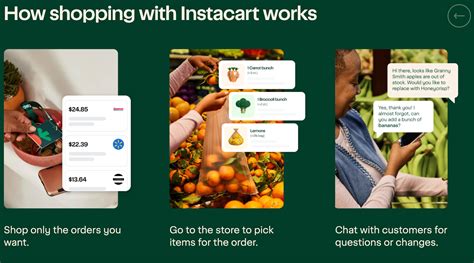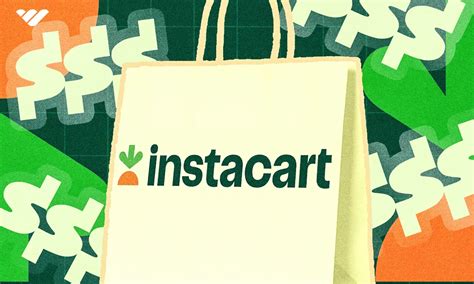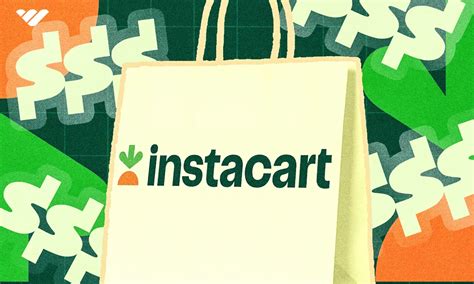In recent years, the gig economy has expanded rapidly, offering flexible work opportunities to individuals seeking alternative income streams. One such gig economy platform is Instacart, a popular grocery delivery service that has gained significant traction, especially during the COVID-19 pandemic. As Instacart shoppers play a crucial role in this on-demand service, many are curious about the earnings potential and income prospects associated with this gig.
This comprehensive guide aims to delve into the earnings of Instacart shoppers, shedding light on the various factors that influence their income. By examining real-world data, industry insights, and personal experiences, we will provide an in-depth analysis of how much money Instacart shoppers can expect to make.
Understanding Instacart Shopper Earnings

Instacart, a leading grocery delivery platform in the United States and Canada, offers a unique opportunity for individuals to earn money by shopping for and delivering groceries to customers. The earnings of Instacart shoppers, also known as “personal shoppers,” vary based on several key factors, including the number of hours worked, the region they operate in, and their efficiency in completing orders.
Instacart shoppers are classified into two primary categories: In-Store Shoppers and Full-Service Shoppers. In-Store Shoppers focus solely on shopping for items within a physical store, while Full-Service Shoppers take on the additional responsibility of delivering the groceries to customers. The earnings potential for each role differs, and we will explore these differences in detail.
In-Store Shoppers
In-Store Shoppers, as the name suggests, work within physical grocery stores, carefully selecting items from the shelves based on customer orders. Their primary responsibilities include reading and understanding the order details, locating the items, and ensuring accurate and timely order fulfillment. In-Store Shoppers do not handle the delivery aspect of the service.
The earnings for In-Store Shoppers primarily consist of two components: a base pay and a service fee. The base pay is determined by the time spent shopping, with a minimum guarantee set by Instacart. For instance, in some regions, the base pay may be $7.50 per order, with an additional $0.25 per item. This means that an In-Store Shopper who completes an order with 20 items in 30 minutes would earn a base pay of $10.00 ($7.50 + $0.25 x 20 items) for that order.
Additionally, In-Store Shoppers receive a service fee, which is a percentage of the total order value. This fee varies depending on the region and the customer's chosen service level. For example, in a region with a 15% service fee, an order totaling $100 would yield a service fee of $15 for the In-Store Shopper.
To illustrate the potential earnings of an In-Store Shopper, let's consider a hypothetical scenario. If an In-Store Shopper completes 10 orders per day, with an average of 20 items per order, and works 5 days a week, their weekly earnings could be calculated as follows:
| Earnings Component | Weekly Earnings |
|---|---|
| Base Pay | $750 ($10 x 10 orders x 5 days) |
| Service Fee (15% of order value) | $750 (assuming an average order value of $50) |
| Total Weekly Earnings | $1500 |

It's important to note that the above calculation is an estimate and may vary based on individual performance, order complexity, and regional factors. Additionally, Instacart provides opportunities for In-Store Shoppers to earn bonuses, such as a "perfect order" bonus for accurately fulfilling orders or a "fast order" bonus for completing orders within a specified time frame.
Full-Service Shoppers
Full-Service Shoppers, on the other hand, take on a more comprehensive role, encompassing both the shopping and delivery aspects of the service. These shoppers not only carefully select items from the store but also deliver them directly to customers’ doorsteps.
The earnings of Full-Service Shoppers are slightly more complex, as they involve multiple components. Similar to In-Store Shoppers, they receive a base pay and a service fee. However, Full-Service Shoppers also earn a delivery fee for each order they complete. The delivery fee varies based on the distance traveled and the time spent on the delivery.
For instance, a Full-Service Shopper who completes an order with 20 items and delivers it to a customer located 5 miles away in 30 minutes might earn a base pay of $10.00, a service fee of $15.00, and a delivery fee of $3.50. This results in a total earnings of $28.50 for that particular order.
To further understand the earnings potential of Full-Service Shoppers, let's consider another hypothetical scenario. If a Full-Service Shopper completes 8 orders per day, with an average of 20 items per order and an average delivery distance of 5 miles, their weekly earnings could be calculated as follows:
| Earnings Component | Weekly Earnings |
|---|---|
| Base Pay | $400 ($10 x 8 orders x 5 days) |
| Service Fee (15% of order value) | $600 (assuming an average order value of $40) |
| Delivery Fee (average of $3.50 per order) | $140 (8 orders x $3.50) |
| Total Weekly Earnings | $1140 |
Again, it's essential to emphasize that these calculations are estimates and can vary based on individual performance, order characteristics, and regional factors. Full-Service Shoppers, like In-Store Shoppers, have opportunities to earn bonuses, such as a "tip bonus" if customers choose to tip them or a "batch bonus" for efficiently completing multiple orders in a single batch.
Factors Influencing Instacart Shopper Earnings

While the calculations provided offer a glimpse into the potential earnings of Instacart shoppers, several factors can significantly impact their income. Understanding these factors is crucial for anyone considering Instacart shopping as a gig.
Region and Market
One of the most significant factors affecting Instacart shopper earnings is the region in which they operate. Different regions have varying customer bases, store partnerships, and demand for Instacart services. As a result, the earnings potential can differ substantially from one area to another.
For instance, densely populated urban areas with a high demand for grocery delivery services may offer more lucrative opportunities for Instacart shoppers. These regions often have a larger customer base, resulting in more orders and potentially higher earnings. Conversely, rural areas with a lower population density may have fewer orders, leading to reduced earnings potential.
Additionally, the market dynamics within a region can influence shopper earnings. For example, regions with a higher cost of living may have customers who are willing to pay a premium for grocery delivery services, resulting in potentially higher service fees and, consequently, higher shopper earnings. On the other hand, regions with a lower cost of living might have customers who are more price-conscious, which could lead to lower service fees and, consequently, lower shopper earnings.
Order Complexity and Size
The complexity and size of orders can also impact Instacart shopper earnings. Orders with a higher number of items or specific requirements, such as special dietary needs or delicate items, may require more time and effort to fulfill accurately. As a result, Instacart’s algorithm often assigns a higher base pay or service fee to such orders to incentivize shoppers to take them on.
For instance, an order with 30 items and a requirement for organic produce might have a higher base pay and service fee compared to a standard order with 20 items. Shoppers who consistently take on more complex orders can potentially increase their earnings by leveraging the additional compensation associated with these orders.
Efficiency and Performance
Instacart shoppers who demonstrate efficiency and high performance can often earn more. The platform’s algorithm takes into account factors such as order completion time, accuracy, and customer satisfaction when determining shopper earnings. Shoppers who consistently deliver orders quickly, accurately, and with high customer satisfaction ratings may receive additional bonuses or be prioritized for more lucrative orders.
Furthermore, Instacart offers various incentives and promotions to encourage shopper efficiency and performance. These can include batch bonuses, perfect order bonuses, and peak pay, which is a higher pay rate during periods of high demand or specific promotions. By leveraging these incentives, shoppers can strategically increase their earnings.
Tips and Additional Compensation
Tips from customers can significantly boost Instacart shopper earnings. While Instacart does not require customers to tip, many customers choose to show their appreciation for the service by tipping their shoppers. The amount of the tip varies and is entirely at the customer’s discretion.
Instacart provides a tipping feature within its app, allowing customers to tip their shoppers either before or after the order is delivered. Shoppers can see the amount of the tip before accepting an order, which can influence their decision to take on a particular order. Additionally, Instacart does not take any portion of the tip; the entire amount goes directly to the shopper.
Apart from tips, Instacart shoppers may also receive additional compensation in the form of referral bonuses. The platform occasionally offers referral programs where shoppers can earn a bonus for referring new shoppers to the platform. These bonuses can provide a significant boost to a shopper's overall earnings, especially if they are actively involved in the referral process.
Maximizing Earnings as an Instacart Shopper
For those interested in maximizing their earnings as Instacart shoppers, several strategies and best practices can be employed. By implementing these tactics, shoppers can potentially increase their income and make the most of their time spent on the platform.
Strategic Scheduling
One of the most effective ways to maximize earnings as an Instacart shopper is through strategic scheduling. By carefully selecting the days and times when they are available to shop, shoppers can tap into periods of high demand and potentially earn more. For instance, weekends and holidays are often peak times for grocery delivery services, as many customers prefer to have their groceries delivered rather than shopping in-store.
Additionally, shoppers can monitor their local market for specific trends and events that might drive up demand. For example, during extreme weather conditions or natural disasters, there may be an increased need for grocery delivery services as customers prefer to stay indoors. By scheduling their availability during these periods, shoppers can take advantage of the higher demand and potentially earn more.
Optimizing Order Selection
Instacart shoppers have the flexibility to choose which orders they accept. By strategically selecting orders, shoppers can increase their earnings. One effective strategy is to prioritize orders with a higher number of items or those that offer a higher base pay or service fee. These orders often require more time and effort to fulfill, but the increased compensation can make them worth the extra effort.
Furthermore, shoppers can consider the distance and travel time associated with an order. Orders that require a shorter travel distance or can be completed in a more efficient route may be preferable, as they can save time and potentially allow the shopper to take on more orders in a given time frame.
It's also beneficial for shoppers to pay attention to customer ratings and feedback. Orders from customers with a history of providing good ratings and feedback might be more likely to result in tips, which can further boost a shopper's earnings.
Maintaining High Performance
Instacart’s algorithm takes into account shopper performance when determining earnings. Shoppers who consistently deliver orders quickly, accurately, and with high customer satisfaction ratings are more likely to receive additional bonuses and be prioritized for lucrative orders. Therefore, maintaining a high level of performance is crucial for maximizing earnings.
To achieve high performance, shoppers should aim for efficiency in their shopping and delivery processes. This includes optimizing their route to the store, efficiently navigating the store layout, and utilizing the Instacart app's features to streamline the order fulfillment process. Additionally, paying close attention to customer instructions and communicating effectively with customers can lead to higher customer satisfaction ratings.
Building Customer Relationships
Instacart shoppers who establish positive relationships with their customers can potentially increase their earnings. By providing exceptional service, shoppers can encourage customers to provide higher ratings and leave tips. Building customer loyalty can also lead to repeat orders, which can be more efficient to fulfill and may result in additional tips.
One way to foster customer relationships is by being responsive and communicative throughout the order process. Shoppers can use the in-app messaging feature to keep customers informed about any potential substitutions, missing items, or delays. By demonstrating a commitment to customer satisfaction, shoppers can build trust and encourage positive feedback.
Future Implications and Industry Trends
As the gig economy continues to evolve, it’s essential to consider the future implications and industry trends that may impact Instacart shopper earnings. By staying informed about these developments, shoppers can adapt their strategies and stay ahead of the curve.
Technological Advancements
The rapid advancement of technology is likely to play a significant role in shaping the future of Instacart and other gig economy platforms. The integration of artificial intelligence, machine learning, and automation could potentially impact the role of Instacart shoppers. While these technologies may streamline certain processes, they could also reduce the need for human intervention in specific tasks.
For example, the use of self-driving vehicles for grocery delivery or the implementation of robotic systems for in-store shopping could reduce the demand for human shoppers. However, it's important to note that these technologies are still in their early stages, and their widespread adoption may take time. Additionally, technological advancements can also create new opportunities, such as the development of more efficient shopping and delivery apps or the integration of virtual reality for an enhanced customer experience.
Market Competition and Regulatory Changes
The gig economy is highly competitive, and Instacart faces competition from other grocery delivery services such as Amazon Fresh, Walmart Grocery, and Shipt. As these competitors gain market share, Instacart may need to adapt its strategies to remain competitive. This could potentially impact shopper earnings, as the platform might adjust its pricing structure or introduce new incentives to attract and retain shoppers.
Furthermore, regulatory changes surrounding the gig economy could also influence Instacart shopper earnings. Several states and cities have already implemented laws that provide gig workers with certain benefits and protections. These regulations could impact the classification of Instacart shoppers and potentially affect their earnings structure.
Customer Preferences and Market Dynamics
Customer preferences and market dynamics are likely to continue evolving, which can impact Instacart shopper earnings. For instance, as more customers embrace online grocery shopping and delivery services, the demand for Instacart shoppers may increase. This heightened demand could lead to higher order volumes and potentially more lucrative opportunities for shoppers.
Additionally, changes in customer demographics and shopping habits could also influence shopper earnings. For example, as more millennials and Gen Z individuals become regular users of Instacart, the platform might adapt its services to cater to their preferences, which could impact the type of orders available and the associated earnings potential.
Conclusion

In conclusion, Instacart shoppers have the potential to earn a significant income by leveraging the platform’s opportunities. By understanding the factors that influence their earnings, such as region, order complexity, efficiency, and customer relationships, shoppers can maximize their income. Strategic scheduling, optimizing order selection, and maintaining high performance are key strategies for success.
While the gig economy and the grocery delivery industry are subject to change, Instacart's continued growth and innovation position it as a reliable source of income for many. By staying informed about industry trends and adapting to changing market dynamics, Instacart shoppers can continue to thrive and make the most of their earnings potential.
Can I make a full-time income as an Instacart shopper?
+Yes, it is possible to make a full-time income as an Instacart shopper. Many individuals have successfully turned Instacart shopping into their primary source of income. However, earnings potential can vary based on factors such as the number of hours worked, region, and efficiency. By maximizing earnings through strategic scheduling, optimizing order selection, and maintaining high performance, Instacart shoppers can increase their income potential.
Do Instacart shoppers receive benefits or employee protections?
+Instacart shoppers are classified as independent contractors and do not receive traditional

